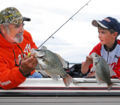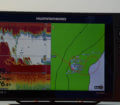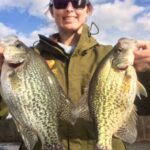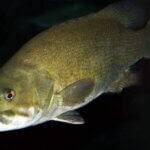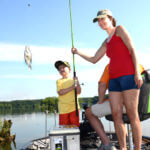Editor’s Note: If you fish visible cover with a pole, sooner or later, you will become a jig pole fisherman. What do you do if you are fishing for crappie with minnows, and you run out of minnows? Do you go home with the fish that you’ve caught and leave the crappie biting? Or, do you continue to fish with nothing but a jig on the end of your line? For many crappie anglers, once they’ve tried jig pole fishing, they’ve become addicted. Even when they’re using minnows, when they find the crappie schooled-up, they will switch to jig pole fishing. Jig pole fishing: allows you to fish your jig vertically through various water depths in even the thickest cover; lets you work the cover more thoroughly than when using a cast-and-retrieve method of fishing; and spooks fewer crappie because you pull the crappie straight up out of the cover instead of dragging that slab through the cover.
 Most people jig pole for crappie the same way they fish with minnows in the spring. They swim the jigs near stumps, logs, sunken trees and any-other structure in the water. Some of the advantages of jig pole fishing are you can fish many-different depths without the aid of a cork, you can cover a lot of water quickly, and you can put your jig around structure where minnows normally swim.
Most people jig pole for crappie the same way they fish with minnows in the spring. They swim the jigs near stumps, logs, sunken trees and any-other structure in the water. Some of the advantages of jig pole fishing are you can fish many-different depths without the aid of a cork, you can cover a lot of water quickly, and you can put your jig around structure where minnows normally swim.
There’s an argument to be made about which method of crappie fishing is better – jig pole fishing or minnow fishing. But rather than getting into an argument with someone, I just fish both ways. I like to catch crappie on minnows and on jigs, but when you’re using a jig pole, you don’t have to worry about minnows dying.
Another advantage is you have the ability to change the color or the size of your bait. I’ve found on some days, crappie prefer a 1/24-ounce jig. On other days, they prefer 1/16-ounce jigs. I also have learned often you can catch more crappie on a chartreuse jig than a pink or an orange jig. Color selection is especially critical when fishing in stained water or extremely-clear water. So, by using a jig pole, you can present the crappie with the size and the color of bait they want to eat under any water or weather conditions.
 The lighter the line, the more crappie you’ll catch. I prefer to fish 4-pound-test line, but if I’m fishing in heavy cover like treetops or brush tops, I may use 6-pound-test line to pull the bigger crappie out of the brush. Too, if I catch a large bass or a catfish, I should be able to muscle it out of the structure more easily with 6-8 pound test line.
The lighter the line, the more crappie you’ll catch. I prefer to fish 4-pound-test line, but if I’m fishing in heavy cover like treetops or brush tops, I may use 6-pound-test line to pull the bigger crappie out of the brush. Too, if I catch a large bass or a catfish, I should be able to muscle it out of the structure more easily with 6-8 pound test line.
I once thought that jig pole fishing meant moving a pole to make the jig move up and down in the water column. However, I’ve found I get many-more bites by swimming the jig around and in the structure or holding it as still as possible. Of course, even if you use both hands and try to hold the jig as still as possible, the jig won’t be motionless. It will move with the water current and the movement of your hand. If you’ve ever watched minnows in an aquarium, you’ll sometimes see them sitting motionless in the water, but from time to time, their tails, dorsal fins and gills still will be moving. By your holding the jig as still as possible, a crappie can come from below or behind the minnow, easily suck the baitfish into its mouth and eat it. With the jig sitting still, the crappie will perform this same action to get its food. So, if the crappie aren’t biting your jig as you swim it slowly around, in and through the structure, try dead-sticking the jig, and watch what happens. Many crappie tournaments have been won by anglers who have learned to dead-stick their jigs in thick cover.
A Jig Can Be Placed Where You Can’t Put a Minnow:
 Another big advantage of jigpoling is you can put a jig where you can’t put a minnow. Often the secret to catching a crappie is to get the bait in a spot where the crappie can see and eat it. You may have to thread your pole into thick cover, under overhanging branches, under low docks or in-between boats. By pulling the jig up to the end of the pole, you then can put the end of the pole right-over the spot where you want to drop the jig.
Another big advantage of jigpoling is you can put a jig where you can’t put a minnow. Often the secret to catching a crappie is to get the bait in a spot where the crappie can see and eat it. You may have to thread your pole into thick cover, under overhanging branches, under low docks or in-between boats. By pulling the jig up to the end of the pole, you then can put the end of the pole right-over the spot where you want to drop the jig.
I first learned the effectiveness of this jig poling technique when I fished with my friend Kent Driscoll of Nolensville, Tennessee, on some Mississippi lakes. Although Driscoll was a tournament fisherman, one of his favorite ways to fish was to put-on a pair of waders and go into shallow water to use his jigpole to trot small jigs into the brush where crappie were spawning. This method was extremely productive, because you could use the jig pole to place a jig where no-other crappie fisherman can reach. You can get your jigpole parallel to the water, slide the end of the pole under a bush and fish the stump of the bush, if you’re in the water instead of in a boat. You often can fish the back sides of stumps and trees where boat fishermen can’t fish, and in many cases you can find and catch bigger crappie by wading and jigpoling than if you fish from a boat. Again, you don’t have to worry about carrying live bait and can attach a stringer to your waders to keep your crappie fresh and alive, until you return to the bank and your vehicle.
Jig poling offers many options to a crappie fisherman. Even when fishing from a boat, you won’t have to worry about keeping your bait alive or running out of bait, and you can change the size and color of your bait.
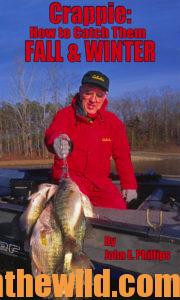
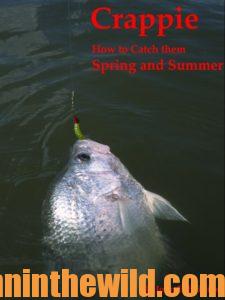 For more tips and information on catching crappie, check out John E. Phillips’ Kindle and print books “Crappie: How to Catch Them Fall and Winter” and “Crappie: How to Catch Them Spring and Summer,” also available from Audible at https://www.audible.com/pd/B06XTV9J2F/?source_code=AUDFPWS0223189MWT-BK-ACX0-083098&ref=acx_bty_BK_ACX0_083098_rh_us. Or, go to http://www.amazon.com/John-E.-Phillips/e/B001HP7K6O to see all of John’s books. To receive and download for free “The Crappie Catchers’ Cookbook,” by John and Denise Phillips, go to https://www.dropbox.com/sh/1tvp5nmxp8jycjf/AAAiOTM6vHolzGV44kO2oEnKa?dl=0.
For more tips and information on catching crappie, check out John E. Phillips’ Kindle and print books “Crappie: How to Catch Them Fall and Winter” and “Crappie: How to Catch Them Spring and Summer,” also available from Audible at https://www.audible.com/pd/B06XTV9J2F/?source_code=AUDFPWS0223189MWT-BK-ACX0-083098&ref=acx_bty_BK_ACX0_083098_rh_us. Or, go to http://www.amazon.com/John-E.-Phillips/e/B001HP7K6O to see all of John’s books. To receive and download for free “The Crappie Catchers’ Cookbook,” by John and Denise Phillips, go to https://www.dropbox.com/sh/1tvp5nmxp8jycjf/AAAiOTM6vHolzGV44kO2oEnKa?dl=0.

